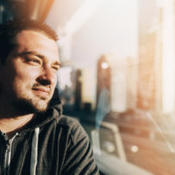 The term antifragile, developed by Nassim Nicholas Taleb, refers to the idea some things actually gain from disorder. The book explores different areas where antifragility can occur, including in businesses, biological systems, and Greek mythology. When exploring how the term fits into psychological well-being, Taleb (2012) defines antifragility as “posttraumatic growth” (p. 691). This begs the question: what if adversity can make a person stronger? This is not a new concept, as the idea of “what doesn’t kill you makes you stronger” can be found in lyrics of hit songs from the past decade (Clarkson, 2011, and West, 2007).
The term antifragile, developed by Nassim Nicholas Taleb, refers to the idea some things actually gain from disorder. The book explores different areas where antifragility can occur, including in businesses, biological systems, and Greek mythology. When exploring how the term fits into psychological well-being, Taleb (2012) defines antifragility as “posttraumatic growth” (p. 691). This begs the question: what if adversity can make a person stronger? This is not a new concept, as the idea of “what doesn’t kill you makes you stronger” can be found in lyrics of hit songs from the past decade (Clarkson, 2011, and West, 2007).
While solid research on the topic of antifragility is still in the beginning stages, another concept similar to this that has been researched extensively is resilience. Once believed by some scholars to be a “magical” ability, research indicates resilience can be purposefully achieved.
Resilience is defined as the ability to “bounce back” after adversity. In Resilience, a book by Southwick & Charney (2012), the authors identify 10 research-based factors that give a person a stronger likelihood to overcome a difficult life event. As they point out in their text, some research indicates more than 90% of the human population will experience at least one adverse event in their lifetime. This could include the death of a loved one, a car accident, a debilitating disease, or a natural disaster, to name a few. The 10 resilience factors fall into roughly four categories: beliefs, attitudes, environment, and health. See below for a description of these factors.
Beliefs
- Optimism or belief in a brighter future
- Having a moral compass or a belief in doing the right thing
- Having a faith that provides a foundation for beliefs about the world
Attitudes
- Facing fear about the situation in an adaptive way
- Looking for meaning, purpose, or growth
- Having flexibility both cognitively and emotionally
Environment
- Relying on social support
- Finding role models who have endured similar situations
Health
- Commitment to physical fitness and strengthening
- Commitment to brain health such as learning options
Putting pressure on healing quickly is not beneficial or even feasible; moving at an appropriate pace is crucial to the process.
After studying these factors, it is clear they are not magical abilities but rather can be incorporated into daily living through practice. And as indicated in the research, a person does not have to utilize all of the above factors to produce health outcomes; one factor can increase the chances of bouncing back after a difficult life event. While this seems simple enough, it is important to recognize that when one experiences a difficult event or a series of difficult events, the internal resources in the body become depleted. Because of this, it is often physically and emotionally harder to exercise these healthy resilience factors (Barrett, 2017).
So how can we begin the process of healing after our resources are depleted from a difficult life event? Before beginning practicing the resilience factors above, try the following suggestions from Brown (2012).
- Allow yourself time to grieve: Adverse events in a person’s life involve some aspect of loss. This can include losing a cherished relationship, losing the promise of a life you once desired, or losing a belief in others. By allowing yourself time to recognize your loss, you are giving yourself more room for healing.
- Acknowledge your emotions: Adverse events can lead to feelings of shame, embarrassment, and despair. Because of these strong emotions, a natural response is to ignore, avoid, or numb the emotions to not have to experience them. The outcome of this behavior is never beneficial for the person in the long run and can lead to adverse physical and mental health outcomes. By recognizing all of our feelings and dealing with them, we are one step closer to healing.
- Create a narrative about your experience: How can we integrate adverse experiences into the overall story of our life? One way to start this process is to find ways to incorporate your adverse experience into your life’s overall message. If you are having trouble doing this, try finding a real-life role model or fictional character that has overcome a similar adversity and how this adversity has given them strength. Therapy for trauma survivors that utilizes these techniques have produced powerful results (Pinskey, 2017).
Ample time to recover from adversity is critical for success. Putting pressure on healing quickly is not beneficial or even feasible; moving at an appropriate pace is crucial to the process. If you’ve experienced a difficult life event and are having trouble bouncing back, please seek help from a licensed professional.
References:
- Barrett, L.F. (2017). How emotions are made: The secret life of the brain. New York, NY: Houghton Mifflin Harcourt.
- Brown, B. (2015). Rising strong: How the ability to reset transforms the way we live, love, parent and lead. New York, NY: Random House Publishing.
- Clarkson, K. (2011). Stronger (what doesn’t kill you). On Stronger. New York, NY: RCA Records.
- Pinskey, D. (2017, June 26). The Dr. Drew podcast: Dr. Janina Scarlet, Tim Ryan and Wes Chapman. The Dr. Drew Podcast. Podcast retrieved from https://itunes.apple.com/us/podcast/the-dr-drew-podcast/id592284993?mt=2&i=389168613
- Southwick, S.M., & Charney, D.S. (2012). Resilience: The science of mastering life’s greatest challenges. New York, NY: Cambridge University Press.
- Taleb, N.N. (2012). Antifragile: Things that gain from disorder. New York, NY: Random House Publishing.
- West, K. (2007). Stronger. On Graduation. New York: NY: Roc-A-Fella Records, LLC.

The preceding article was solely written by the author named above. Any views and opinions expressed are not necessarily shared by GoodTherapy.org. Questions or concerns about the preceding article can be directed to the author or posted as a comment below.

 Psychological Spinach: Building Resilience by Embracing Your Truth
Psychological Spinach: Building Resilience by Embracing Your Truth Decision-Making Techniques: Learning to Use Your Head, Heart, and Gut
Decision-Making Techniques: Learning to Use Your Head, Heart, and Gut Trust Your Longing for Social Engagement. It’s for Your Own Good!
Trust Your Longing for Social Engagement. It’s for Your Own Good!

Please fill out all required fields to submit your message.
Invalid Email Address.
Please confirm that you are human.
Leave a Comment
By commenting you acknowledge acceptance of GoodTherapy.org's Terms and Conditions of Use.